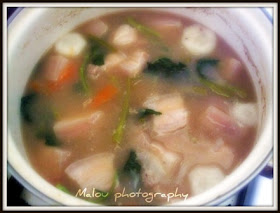
1/2 kilo large shrimps
1/2 teaspoon salt
1 tablespoon kalamansi or lemon juice
Batter:
1 egg, slightly beaten
1 cup cold water
1 1/2 teaspoons baking powder
1 1/2 cups All-purpose flour
1/4 teaspoon salt
oil for frying
Sweet and Sour Sauce:
1 cup water
1 teaspoon sugar
2 tablespoons catsup
1 1/2 teaspoons hot sauce
1/4 teaspoon salt
1 teaspoon cornstarch dissolved in some water
Peel shrimps but leave the tails intact. Devein and cut halfway through so the shrimps won't curl when they are cooked. Marinate the shrimps in salt and kalamansi or lemon juice. Set aside for a few minutes.
Prepare Batter: Combine egg and cold water. Add the sifted dry ingredients and blend well. Dip the shrimps in the batter. Deep-fry in hot oil. Serve with sweet and sour sauce.
Prepare Sauce: In a small saucepan, combine water, sugar, catsup, hot sauce and salt. Bring to a boil. Thicken with dissolved cornstarch.
Courtesy of Filipino Kitchen Library







